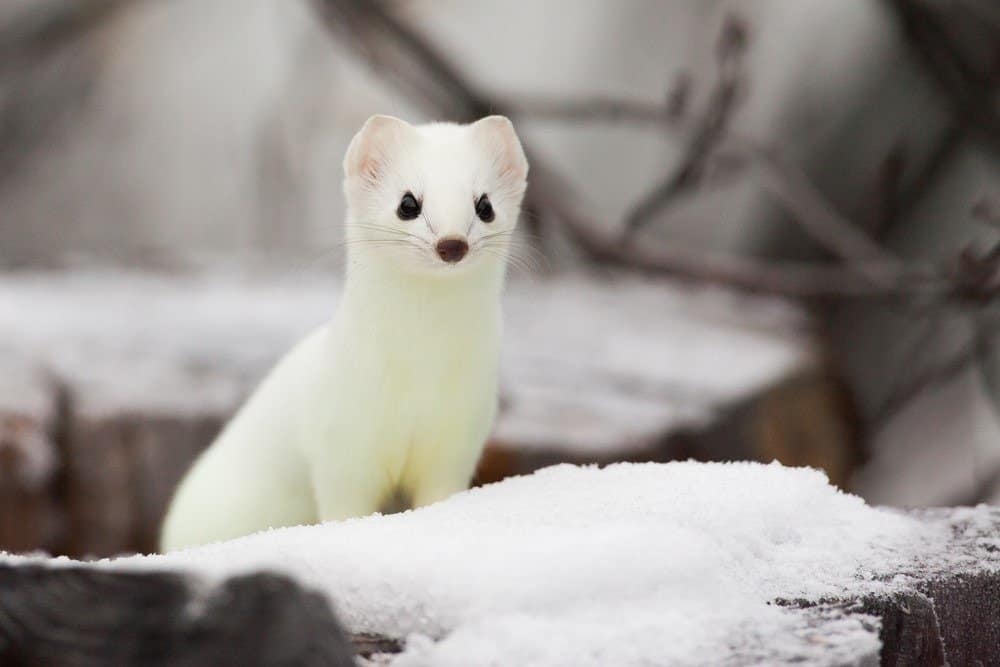You may not have realized that there is a difference between a stoat vs weasel. While both of these creatures belong to the same family of animals, there are some key features that distinguish them from one another. But what might those be, and how can you learn to tell them apart simply by looking at them?
In this article, we will address all of the different physical features and behavioral traits of stoats and weasels so that you can learn how to tell them apart. Let’s get started and learn more about these two unique animals now!
Comparing Stoat vs Weasel

| Stoat | Weasel | |
|---|---|---|
| Genus | Mustelidae | Mustelidae |
| Appearance | Shorter tail, often highlighted with a black tip, especially during the winter. Coat changes to an all white shade, but is frequently found in black and brown during the rest of the year | Longer tail, clawed feet ideal for living on land, and found in different shades of brown and black. In the winter, weasels gain a white winter coat for camouflage and they molt twice per year |
| Preferred Time of Day | Active in the evening and throughout the night | Primarily diurnal (active during the daytime) |
| Size | 7 to 13 inches long; 1-2 pounds | 8-15 inches long; 2-4 pounds |
| Diet | Mice, rabbits, voles, amphibians, and birds | Mice, rodents, rabbits, lemming, ducks |
Key Differences Between Stoat vs Weasel

Both of these creatures gain camouflage in the winter time, but stoats have a trademark black tip to their tail, while weasels will not.
©Martin Prochazkacz/Shutterstock.com
There are a few key differences between stoats and weasels. While both of these animals are technically weasels, stoats tend to be smaller and weigh less than weasels overall. Both of these creatures gain camouflage in the winter time, but stoats have a trademark black tip to their tail, while weasels will not. Finally, stoats prefer to be active in the evening and night time, while weasels are primarily diurnal or are active during the day.
Let’s check out these differences in greater detail now.
Stoat vs Weasel: Size

Stoats prefer to be active in the evening and night time, while weasels are primarily diurnal or are active during the day.
©Krasula/Shutterstock.com
While it may be a subtle difference, stoats differ from weasels in terms of their overall size and weight limits. For example, weasels grow up to 8-15 inches long and weigh 2-4 pounds, and stoats grow up to 7 to 13 inches long and weigh 1-2 pounds. You may not be able to tell these subtle differences unless you look at these two animals side by side, but it is an important distinction to make.
Stoat vs Weasel: Habitat Preferences and Behavior
Another difference between a stoat vs weasel is their behavior and habitat preferences. While both of these creatures continually encroach on urban areas given they’re opportunistic foraging habits, stoats prefer woodland and grassy areas, while weasels enjoy more populated areas where they can easily find food.
These two animals also have different times of day that they prefer to be active. For example, stoats are primarily nocturnal, while weasels are diurnal. This means that stoats are active primarily during the evening and night time, while weasels are active during the day. However, this may depend on specific species and locations around the world. The geographical locations of these two animals overlap frequently, but both stoats and weasels prefer to be solitary creatures, often getting into territorial disputes with other animals of their same species.

Weasels grow up to 8-15 inches long and weigh 2-4 pounds, and stoats grow up to 7 to 13 inches long and weigh 1-2 pounds.
©Agami Photo Agency/Shutterstock.com
Stoat vs Weasel: Appearance and Coat Colors
Another difference between stoats and weasels lies in their appearance and coat colors. While it can be incredibly difficult to tell the difference between a stoat and a weasel at first glance, the stoat always has a shorter tail when compared to a weasel. In fact, stoats are often known as the short-tailed weasel.
Speaking of tails, the stoat can also be identified from a weasel based on their tail colors in the winter. While both of these creatures are unique in that they shed their coat twice a year and earn camouflage in the winter time, stoats maintain a black tip to their tail, while weasels do not. This makes stoats particularly striking in the winter time, given that the rest of their coat is a pure white shade.
When it isn’t winter time, both of these creatures range in color from black to tan, and they both maintain a white chin and underbelly. Given how thick and waterproof their coats are, it is necessary for them to molt or shed their fur twice per year.

While it can be incredibly difficult to tell the difference between a stoat and a weasel at first glance, the stoat always has a shorter tail when compared to a weasel.
©Jukka Jantunen/Shutterstock.com
Stoat vs Weasel: Diet and Hunting Style
Another difference between a stoat vs weasel is their diets and hunting style. While both of these animals are carnivorous and aggressive to boot, weasels tend to take down larger prey than stoats do. This is likely due to their size, but both creatures tend to seek out locations with a wide variety of rodents available for them to eat.
Stoats prefer to eat mice, rabbits, voles, amphibians, and birds, while weasels enjoy eating mice, rodents, rabbits, lemming, ducks. Both of these animals bite their prey on the neck in order to take them down, but weasels are notorious for taking down prey much larger than them.
Stoat vs Weasel: Reproductive Cycle

Stoats maintain a black tip to their tail in the winter, while weasels do not.
©Colin Seddon/Shutterstock.com
A final difference between stoats and weasels is their reproductive cycle. A stoat is unique in that it is capable of a process called embryonic diapause. This essentially means that they can store their fertilized eggs for up to 300 eggs before beginning their true gestation cycle. Weasels are not capable of this, and tend to give birth within five weeks.
The photo featured at the top of this post is © Krasula/Shutterstock.com
Thank you for reading! Have some feedback for us? Contact the AZ Animals editorial team.






